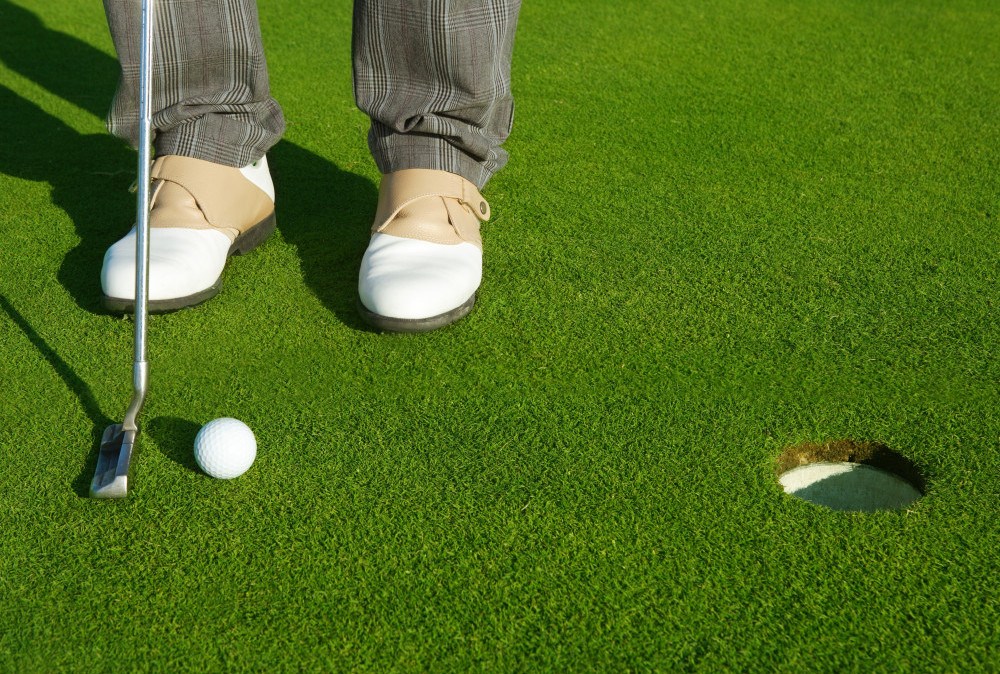I have written a few articles recently about the golf swing. My thinking was to maybe find a few tips that could both make practice more interesting and perhaps help people fix their own swings. I am always a bit hesitant to do this because I not a PGA pro, not a golf instructor and not someone who spends their time teaching others how to play the game. However, I do spend a lot of time looking, learning and thinking about the game. This got me thinking about where we all start. Just what are the golf swing basics?
Why Are Golf Swing Basics so Important?
In fact, before starting to think about just what these basics are exactly, maybe it is even more important to think about why they are important. Perhaps we should even swap the word “basics” for “fundamentals”. This might seem strange at the start because I have said often enough that there are lots of ways to swing a golf club and lots of ways to play good (or bad) golf. This is patently true to anyone who has watched any high-level golf, either in person or on TV. going from Bryson Dechambeau to Rory McIlroy is going from one swing to a very different one. And these two are not really that extreme compared to others who have graced the professional ranks over the years.
I am sure Jim Furyk comes to many people’s’s minds immediately, but his is far from the most unusual swing to have played the game professionally.
There are plenty of other examples out there, from split hands to over the top, pauses halfway to half swings. And don’t get me started on Eamonn Darcy!
This would seem to say that there are no such things as basics after all. Surely these golfers have little to nothing in common? This is where I would disagree.
To illustrate how things that can see so different are perhaps connected, let me tell you about the group of people I golf with most often. We are a group of around ten or so golfers and we live mostly in the same area. We don’t manage to get on course at the same time that often, but generally a few of us play together in different combinations at different times. Our handicaps range from scratch all the way up to mid twenties.
We do spend quite a bit of time on WhatsApp talking about all things golf. One of our number (let’s call him Bob) is in a never-ending quest to improve his game and especially his swing. He has what might be considered a less than orthodox swing. His grip is very strong and his holds the club in an extremely vertical position at address. He plays solid enough golf to around a 15 handicap or so and can actually play quite a bit better now and again.
After one particular discussion online about strong grip vs weak grip and various other details of the swing, the best golfer in the group (“Jim”) said to him that all the stuff that Bob was worrying about in his swing didn’t really matter. Initially, I found this a bit strange. Surely all the work Bob was putting in was really important? Jim explained his point and the more I think about it, the more I believe that Jim is exactly right.
He said, and I paraphrase a little, that it really doesn’t matter exactly what Bob is doing in terms of his swing. The things that his is trying to change and improve are, essentially, irrelevant for Bob. The big problem in Bob’s swing is not the stuff that might jump out at you the first time you see him. Those high hands, that funky follow through. Bob needs to get his fundamentals in place. Until his does this, the rest is just fluff.
What is the Base of the Pyramid?
The thing here is that all effective golf swings are going to have a few key things that are the same. They might look very different. Trying to get a swing to look better or at least more traditional is a pointless exercise if the golfer doesn’t address the basics that condition all the rest. This as the point that Jim was trying to get Bob to see. As long as his has the base of his pyramid firmly in place and the foundations are solid, the rest doesn’t matter. And the opposite is also true. A swing might look, at least to the untrained eye, to be very good, but if it doesn’t respect the basics, it really isn’t.
Enough of an introduction, just what are these basics? The first thing that is key in my opinion (and that of a lot of people who know far more about the golf swing than I) is posture.
If we go back to all the golfers from the video above, the most obvious thing to the untrained eye are the differences. Flat, upright, long, short, elbows in or out etc. But if we wind all these swings back to their starting point, they would all be in a very solid posture. This is key because it really is the base of the pyramid in a very literal sense. It is literally impossible to hit the ball consistently well if you haven’t got a solid starting point. Whether you are looking for distance, accuracy or both (and who isn’t?) there is no way it is happening from anything other than a balanced starting point.
This doesn’t mean that only one stance is possible. Thee are many small differences between quality ball strikers. They might be slightly wider or narrower, have that leading foot slightly flared and back or closed and forward. Regardless, these differences tend to be quite small. They also tend to a function of out own physiology and, as we progress, an attempt to influence our shot shape, either to limit a miss or to encourage a draw or fade for example.
A Solid Stance
To me, it makes sense to start with something fairly neutral before trying the extremes. This is what is often called an athletic stance. Feet wider than shoulder-width, a soft knee (so slightly bent but certainly not squatting down,) a gentle bend at the hips (not really the waist) and arms hanging down comfortably, not reaching for the ball or bent because we are too close.
This might seem like a lot of instruction, but what it really means is the most natural thing in the world. To get it right, simply take a club and address the ball without worrying about hitting it. For almost all golfers, you will naturally adopt the stance that is most comfortable for your body type, and this is going to fit in with the guidelines above. If all you get from article is to find your own athletic set up stance, you have already gone a decent way to giving yourself every chance of hitting the ball well.
This stance shouldn’t feel forced. As an example, my natural stance is perhaps more bent over than many people’s. This is not really surprising, given that I am well above average height and have spent a good deal of my golfing career playing with standard spec clubs. In fact, I often use standard clubs now, or shorter, simply because I like to play with some classic irons which are almost always in standard length and often in the shorter standard lengths of a few decades ago.
This perhaps doesn’t given be perfect bio mechanics, but if you saw me swing, you would still (I hope) identify it as a fluid, somewhat athletic movement. Regardless of the club or the club length, my posture and stance mean that I stand a good chance of making regular, solid contact. The base of my pyramid is solid.
Is a Good Grip important?
What comes next is a little bit more controversial. Nobody is going to argue that an unstable stable is the best way to play golf, but grip is a whole other kettle of fish! In fact, I am not even sure if it should count as a basic at all, given it can vary so much. But it is vital for one particular reason: the grip is the connection between you and the club.
I don’t believe that there is one way to grip a club but I do strongly believe that the grip fits in with the whole swing. What exactly do I mean by this? Well, there is nothing especially wrong with a strong right hand in the grip, for example. However, for someone who tends to hit the ball low with a draw, this grip will have them hooking it straight left over the fence in many cases.
Likewise, a weak grip can be fine. If you already hit a high fade, a weak grip will more than likely lead to a ball flight that is short, high and right drifting further right. However, if you change these two golfers’s grips, they could well find something that works perfectly. The grip is simply a cog in the whole swing but a vital one in that it connects ball to body via the club.
Personally, I use the club to adjust my ball flight tendencies. As someone who at one point was very scared of a left miss, I used a slightly (and I repeat, slightly) weaker grip. Previously, I strengthened my grip a little to turn a natural fade into a baby draw. Now apart from the fact that I wish I had left this little fade alone and never tried to hit a draw like the “good” players (yes, Martin Kaymer, I feel your pain), I did this deliberately and slowly.
Grip might be controversial as a golf fundamental, but in my experience, the fasted way to lose and good ball striking you might have built up is to radically change the grip. Use what works, whether it is a ten finger split grip, overlap, Vardon, strong or weak, but be aware of the fact that this is, quite literally, the centre of the golf swing and mess with it at your peril.
Takeaway, Wrist Position, Plane
At this point, you might expect me to move on to something like takeaway. Maybe slow and wide should be key. Perhaps it is the importance of a vertical takeaway. Actually, I feel like this is something that is given far too much importance. I have seen really good ball-striking from golfers creating a wide arc and also from golfers who almost lift the club straight up. To be honest, I have seen terrible ball striking from these two groups too!
Some golf instruction sets a huge amount of importance by these positions. I am not competent to judge whether this is right or wrong. There are some absolutely amazing instructors who insist on hitting exact positions both on the back swing and downswing. Maybe they are right. However, and equally as common, are the first-rate teachers who don’t even look at this sort of stuff. They might simply work with what the student naturally does, or give just the broadest indications in terms of the actual swing.
With this being the case, it seems to me that it can really be considered as something which is fundamental to the success of the swing.
The same goes for all the other “details”, for example whether the wrist is bowed or flexed or whether the swing plane is flat or upright. I am certainly not saying that these things have no effect of what happens to the golf ball after impact. They have a large effect on the clubhead’s path into and through his ball and the speed of the clubhead as it reaches the ball, which is clearly going to make a pretty big difference to where it goes and at what speed.
The thing is, they aren’t uniform throughout the golfing world at the elite level. So what is? I think there is really only one thing that can be considered a swing key and it has a result that is present in every good ball striker, regardless of the idiosyncrasies of their swing.
Weight Forward-the King of Golf Swing Basics
Moving our weight forward as we hit the ball (and beyond) unites all good ball strikers. In fact, it might be the one thing that separates the wheat from the chaff in terms of golf. You will often hear about making the divot after the ball, the famous ball first, turf second contact, but all this really means is that the golfer’s weight is well onto the front foot and continuing to move forward at the moment of strike.
To understand just why this is so important, maybe the easiest way is to think about the average golfer and their swing. I don’t mean the complete beginner, I mean somebody who can play a big, perhaps a bogey golfer or slightly better. This golfer will hit some solid shots. Distance won’t be comparable with a really good golfer, neither will accuracy. There will also be a big difference in terms of strike. If you were to look down at the divots after every shot, now and again there would be a divot after the ball, but also sometimes a big trench just before from a fat shot or perhaps nothing at all as the ball is taken clean. If this golfer is on the better end of average, there would probably be a majority of divots that were basically under the ball.
Now compare this to quality ball striker. Not necessarily someone from the PGA tour, but perhaps one of the better players in your local club. This person will have the majority of their divots in the same place, just after the ball with their irons. The resulting shots will tend to have that crisp sound, a more consistent ball flight with much less dispersion, especially front to back and almost certainly more distance.
What makes this so? This person will have their weight on that front foot moving forward as they hit. This is of course easier to say than to actually put in practice every time, but it does tend to be overlooked for beginners. Maybe someone will see it, but it is put in the “deal with later” category while other “mistakes” are being corrected. This is, in my opinion, a shame because it should be at the top of the list, the true vase of the golf swing pyramid.
Building a Solid Base to Your Swing
So there you have it. It might not be the most popular opinion in the golfing world, but I believe that if all golfers started with a stable, athletic posture, a grip that works in harmony with the rest of their swing and perhaps crucially a real effort to move forward into and through the ball at impact, there would be a lot more decent ball strikers in the game at all levels.





